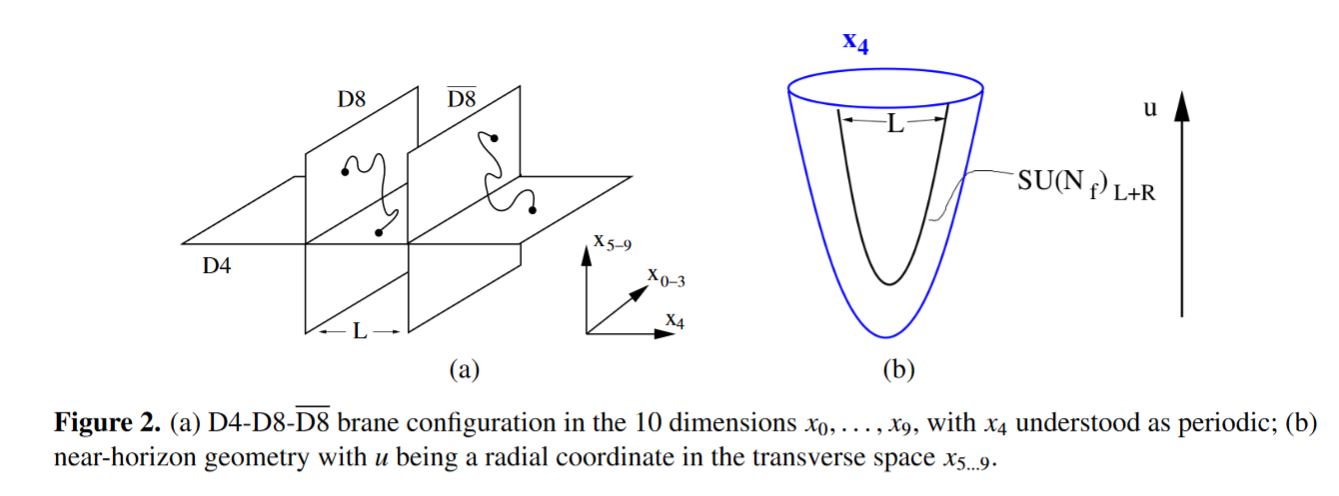nLab D4-D8 brane bound state
Context
String theory
Ingredients
Critical string models
Extended objects
Topological strings
Backgrounds
Phenomenology
Contents
Idea
bound states of D4-branes with D8-branes. A special case of the general phenomenon of Dp-D(p+4)-brane bound states.
Properties
As a black brane
As a black brane supergravity solution: Brandhuber-Oz 99, Nastase 03, Sec. 2 and 3, BSU 09, Van Pol 15, Sec 5, Dibitetto-Petri 18
As geometric engineering of QCD
The D4-D8 system is the intersecting D-brane model underlying the Witten-Sakai-Sugimoto model for holographic QCD

graphics grabbed from Erlich 09, section 1.1

graphics grabbed from Rebhan 14
As instantons on the D8-brane
Generally, due to the higher WZW term in the Green-Schwarz sigma model for D(p+4)-branes, Yang-Mills instantons in the Chan-Paton gauge field on -branes are equivalently Dp-D(p+4)-brane bound states (see e.g. Polchinski 96, 5.4, Tong 05, 1.4).
In terms of holographic QCD as above these instantons correspond to baryon-bound states (Sakai-Sugimoto 04, 5.7).

graphics grabbed from Sugimoto 16
Related entries
brane intersections/bound states/wrapped branes/polarized branes
-
D-branes and anti D-branes form bound states by tachyon condensation, thought to imply the classification of D-brane charge by K-theory
-
intersecting D-branes/fuzzy funnels:
-
Dp-D(p+6) brane bound state
References
As black brane solutions
General
As black brane supergravity-solutions:
-
Andreas Brandhuber, Yaron Oz, The D4-D8 Brane System and Five Dimensional Fixed Points, Phys.Lett. B460:307-312, 1999 (arXiv:hep-th/9905148)
-
Horatiu Nastase, Sections 2, 3 of: On Dp-Dp+4 systems, QCD dual and phenomenology (arXiv:hep-th/0305069)
-
Pierre Binetruy, Misao Sasaki, Kunihito Uzawam, Dynamical D4-D8 and D3-D7 branes in supergravity, Phys. Rev. D80:026001, 2009 (arXiv:0712.3615)
-
Oren Bergman, Diego Rodriguez-Gomez, Section 2.3 of: 5d quivers and their duals, J. High Energ. Phys. (2012) 2012: 171 (arXiv:1206.3503)
-
Bert Van Pol, Section 5 of: Aspects of D-branes in supergravity, thesis 2015 (pdf, pdf)
-
Giuseppe Dibitetto, Nicolò Petri, Surface defects in the D4-D8 brane system, J. High Energ. Phys. (2019) 2019: 193 (arXiv:1807.07768)
-
Minwoo Suh, D4-D8-branes wrapped on a manifold with non-constant curvature (arXiv:2108.08326)
With D2/D6-defects realizing
blackD4-D8-brane bound states in massive type IIA string theory, with defect D2-D6-brane bound states inside them realizing AdS3-CFT2 “inside” AdS7-CFT6:
-
Giuseppe Dibitetto, Nicolò Petri, Surface defects in the D4 − D8 brane system, JHEP 01 (2019) 193 (arxiv:1807.07768)
-
Giuseppe Dibitetto, Nicolò Petri, vacua and surface defects in massive IIA (arxiv:1904.02455)
As geometric engineering of QCD
With application to geometric engineering of QCD (“holographic QCD”, such as the Witten-Sakai-Sugimoto model):
-
David Morrison, Nathan Seiberg, Extremal Transitions and Five-Dimensional Supersymmetric Field Theories, Nucl. Phys.B483:229-247, 1997 (arXiv:hep-th/9609070)
-
Hee-Cheol Kim, Sung-Soo Kim, Kimyeong Lee, 5-dim Superconformal Index with Enhanced En Global Symmetry, JHEP 1210 (2012) 142 (arXiv:1206.6781)
-
Chiung Hwang, Joonho Kim, Seok Kim, Jaemo Park, General instanton counting and 5d SCFT (arxiv:1406.6793)
Review:
- Yolanda Lozano, Section 2 of: Hints on 5d Fixed Point Theories from Non-Abelian T-duality, IFT 2014 (slides pdf, pdf)
As a model for baryons:
- Tadakatsu Sakai, Shigeki Sugimoto, Low energy hadron physics in holographic QCD, Prog. Theor. Phys.113:843-882, 2005 (arXiv:hep-th/0412141)
Among review of the Witten-Sakai-Sugimoto model:
-
Joshua Erlich, How Well Does AdS/QCD Describe QCD?, Int. J. Mod. Phys.A25:411-421,2010 (arXiv:0908.0312)
-
Anton Rebhan, The Witten-Sakai-Sugimoto model: A brief review and some recent results, 3rd International Conference on New Frontiers in Physics, Kolymbari, Crete, 2014 (arXiv:1410.8858)
General --brane bound states
The argument that Yang-Mills instantons in the Chan-Paton gauge field on a D(p+4)-brane are equivalent to Dp-D(p+4) brane bound states goes back to
-
Edward Witten, Small Instantons in String Theory, Nucl. Phys. B460:541-559, 1996 (arXiv:hep-th/9511030)
-
Michael Douglas, Gauge Fields and D-branes, J. Geom. Phys. 28 (1998) 255-262 (arXiv:hep-th/9604198)
Review is in:
-
Joseph Polchinski, Section 5.4 of: TASI Lectures on D-Branes (arXiv:hep-th/9611050)
-
David Tong, Section 1.4 of TASI Lectures on Solitons (hep-th/0509216)
Discussion specifically of D0-D4-brane bound states:
- Cumrun Vafa, Instantons on D-branes, Nucl. Phys. B463 (1996) 435-442 (arXiv:hep-th/9512078)
with emphasis to the resulting configuration spaces of points, as in
- Cumrun Vafa, Edward Witten, Section 4.1 of: A Strong Coupling Test of S-Duality, Nucl. Phys. B431:3-77, 1994 (arXiv:hep-th/9408074)
Discussion specifically of D1-D5-brane bound states
- Neil Lambert, D-brane Bound States and the Generalised ADHM Construction, Nucl. Phys. B519 (1998) 214-224 (arXiv:hep-th/9707156)
Last revised on August 30, 2021 at 12:30:39. See the history of this page for a list of all contributions to it.